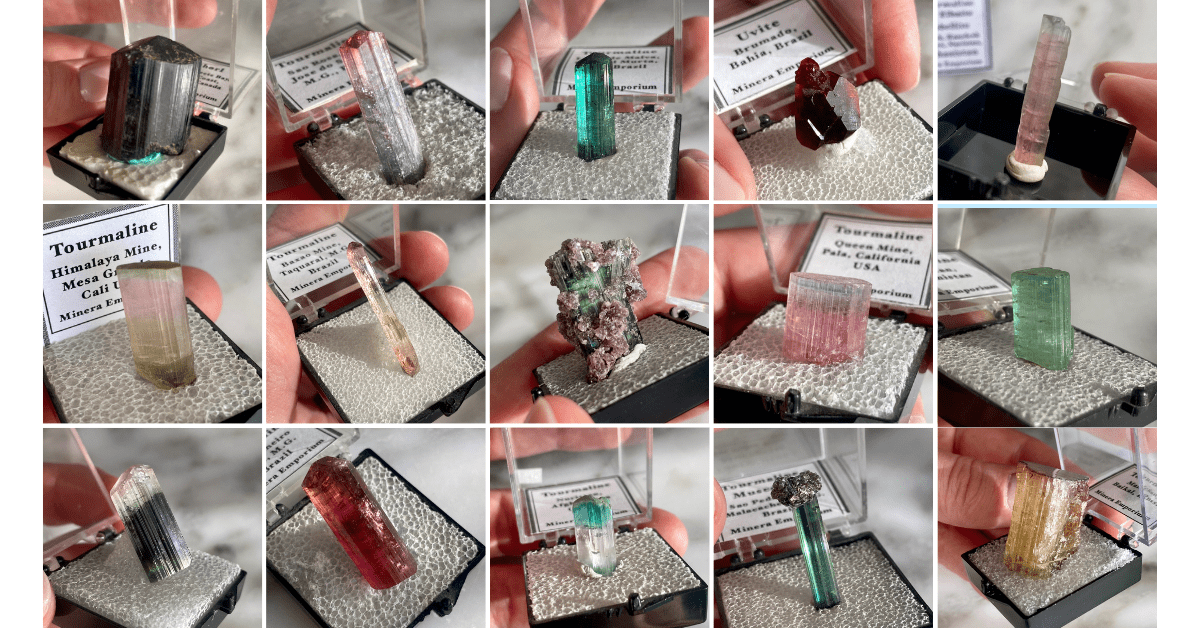

Tourmaline is one of the most sought after gemstones by mineral collectors and jewellers alike, due to the dazzling array of colours it comes in, as well as its unique mineral properties. There are different types of tourmaline. This captivating gemstone has a rich history and has enthralled civilizations for centuries.
Minera Emporium is thrilled to offer a wide selection of tourmalines coming from various localities around the world. This article will cover a brief history of tourmaline, its general mineral properties, its value, main deposits around the world as well as a lexicon of terminologies used when defining different types of tourmaline.
Table of Contents
The history of tourmaline dates back to ancient times, where it was initially mistaken for other gemstones due to its diverse colours. The name “tourmaline” is derived from the Sinhalese word “turmali,” which means “mixed,” reflecting the gem’s varied colour spectrum.
Historical records suggest that tourmaline deposits were first discovered in Sri Lanka, where it was revered for its striking appearance and believed to bring protection and good fortune to the wearer.
While early civilizations may have mistaken tourmaline for other gemstones, its unique mineral properties eventually garnered recognition. Its vivid colours as well as it’s durability, which make it ideal for jewelry-making, made it very popular.
As trade routes expanded and civilizations interacted, tourmaline found its way into different cultures, each attributing unique meanings and properties to the gemstone.
As civilizations expanded their knowledge of gemstones, tourmaline gained prominence in various cultures. The gemstone began to be extracted from diverse locations around the world, with notable deposits in countries such as Brazil, Afghanistan, and the United States.
Jewellers quickly recognized the potential of tourmaline for creating exquisite, durable pieces, and it became a sought-after gem for both ornamental and spiritual purposes.
The popularity of tourmaline in jewelry can be attributed to its remarkable colour range, which spans from vibrant pinks and reds, to captivating greens, remarkable blues, and more. Its versatility allows for unique and intricate designs, making it a favorite among designers and gemstone aficionados alike. Rubellite, with its captivating pink to red hues, is especially cherished and often used as the focal point in high-quality jewelry pieces.
The value of tourmaline has evolved over the centuries, influenced by factors such as colour intensity, clarity, and carat weight. In the mid-20th century, the discovery of intensely colourful tourmalines in Brazil elevated the gemstone’s status, leading to increased demand and higher market values. Today, the value of tourmaline continues to be influenced by factors like locality, colour saturation, size, and the overall quality of the gem.
Where is tourmaline found? Tourmaline deposits can be found on nearly every continent, each yielding unique variations of the gemstone. Brazil remains a significant source, producing a wide range of tourmaline colours, including the highly prized rubellite. Afghanistan is renowned for its impressive indicolite and verderite specimens, while the United States, particularly California and Maine, has been a historical producer of gem-quality tourmalines, including the black variety known as schorl.
Other notable tourmaline deposits include those in Madagascar, Namibia, and Nigeria, each contributing to the global availability of this captivating gemstone. Mines in Madagascar, for instance, have produced stunning bicolour and multicoloured tourmalines that are highly prized by collectors.
The tourmaline group is a family of complex borosilicate minerals with a wide range of chemical compositions. Variations in the chemical composition, such as elements of aluminum, iron or magnesium, affect its colour.
Due to the different types of tourmaline available on the market, different terminology has been established to define specific types of specimens.
Here are some of the specific terms related to different types of tourmaline:
Elbaite tourmaline, known for its vivid and varied colours, has several distinctive terms used to describe specific colour patterns or combinations. Here are some terms commonly used to define colourful elbaite tourmalines:
These terms reflect the incredible diversity of elbaite tourmaline and the mesmerizing array of colours and patterns that make each specimen unique. Gem enthusiasts and collectors often value these distinct varieties for their rarity, beauty, and individual characteristics.
It’s important to note that the names mentioned above refer to colour variations within the tourmaline group rather than distinct mineral species.
Tourmaline crystals can contain a range of chemical elements, resulting in a diverse array of colours and properties. Gemologists and mineralogists often classify tourmalines based on their colour, chemical composition, and crystal structure to better understand and appreciate the unique characteristics of each specimen.
We hope you’ve enjoyed learning more about different types of tourmaline and what makes different specimens of this crystal family so special. Tourmaline’s captivating beauty and rich history have positioned it as a prized gemstone in both the jewelry industry and the world of mineral collecting. With its diverse colors, unique properties, and valued deposits across the globe, tourmaline continues to captivate the hearts of gem enthusiasts, adding a kaleidoscope of hues to the world of precious gemstones. It is definitely one of our favourite gems! We hope this information will support your future acquisitions!
Make sure to check out our tourmaline collection here!
Happy collecting!
Montreal’s highly anticipated springtime gem show is fast approaching! Mark your calendars for the 38th…
The Ottawa Rock N' Gem Show is set to dazzle attendees from April 10 to…
The National Women’s Show of Montreal 2025 will take place from March 28 to 30,…
The Montreal Nature Expo, held on March 1st and 2nd, 2025 is a remarkable event…
Before looking into crystals for Libra, let's go over what is associated to this zodiac…
The fall season is upon us, which means the 63d Annual Montreal Gem and Mineral…
This website uses cookies.